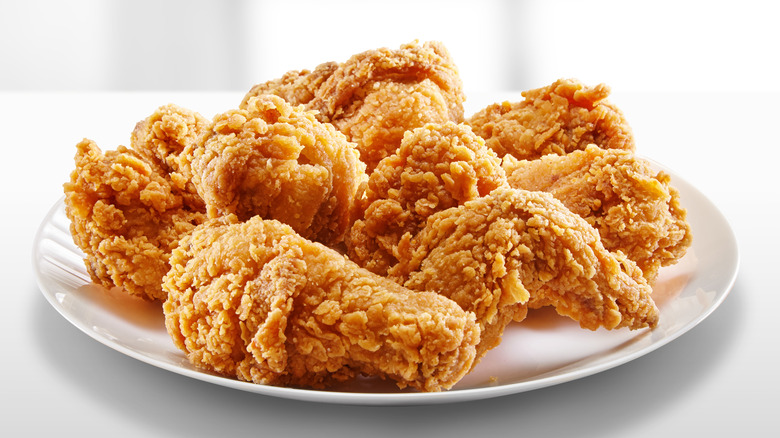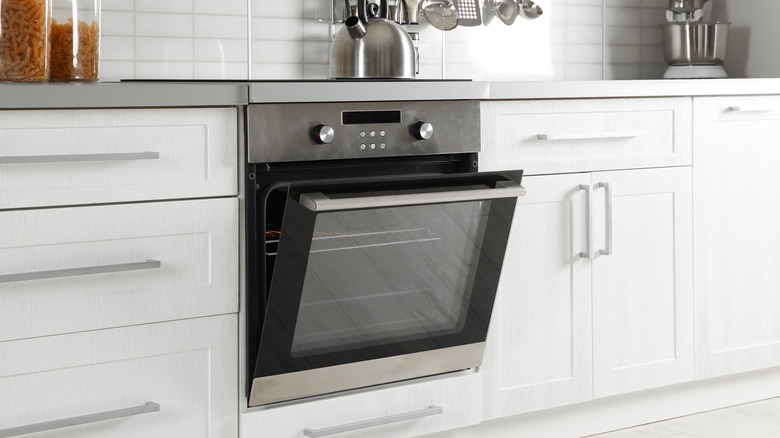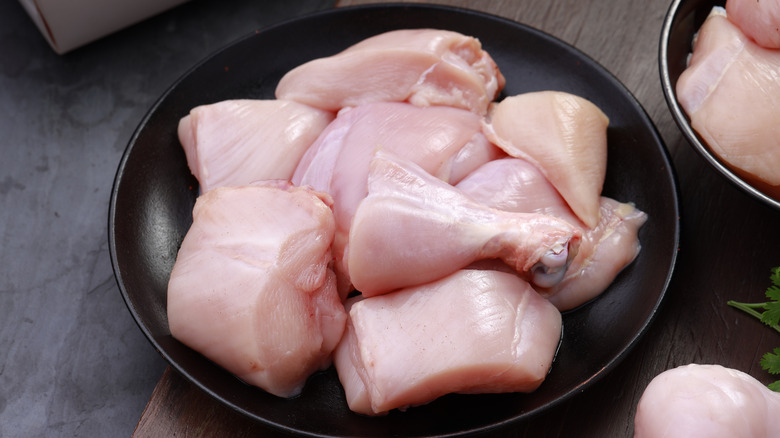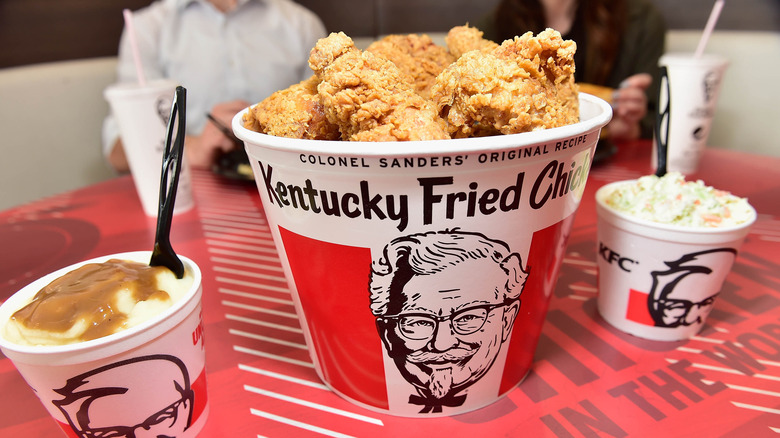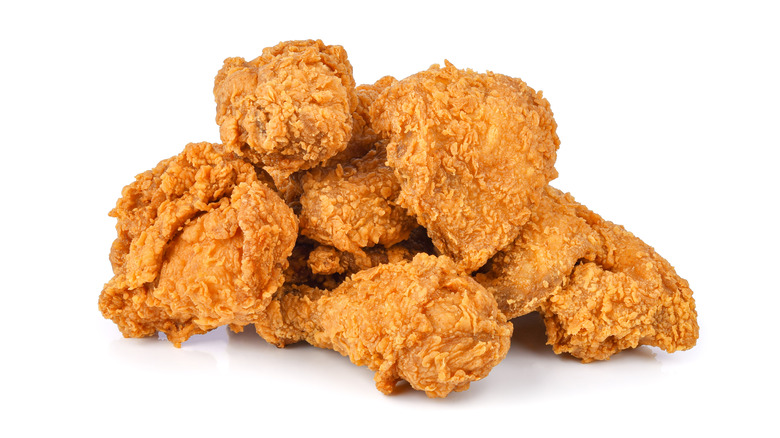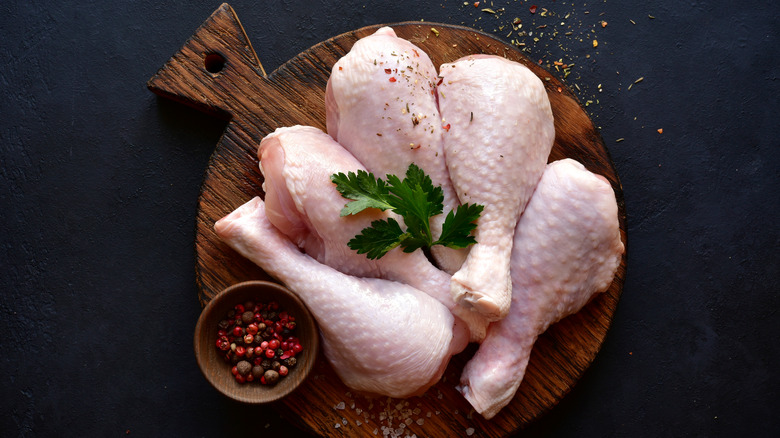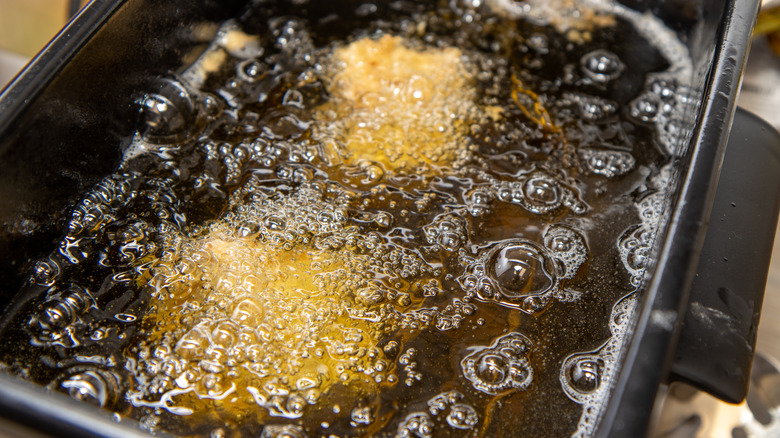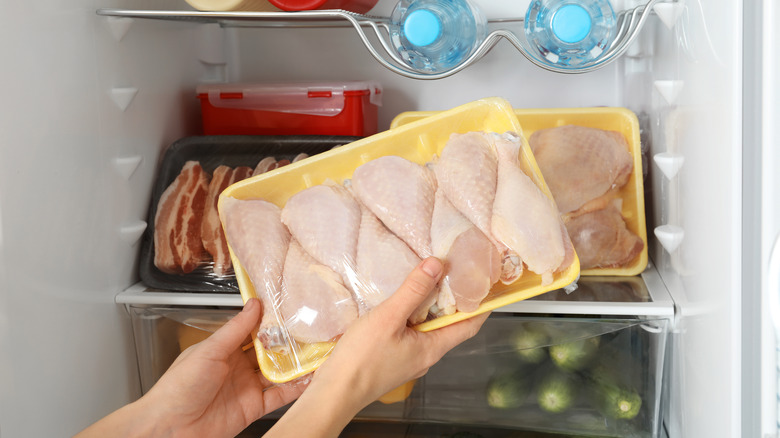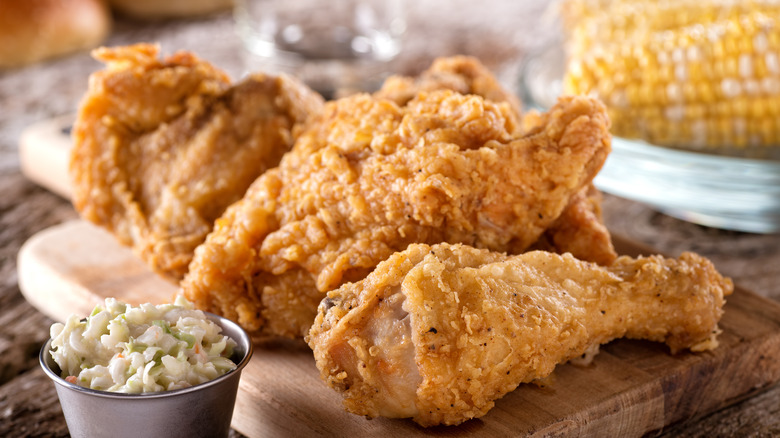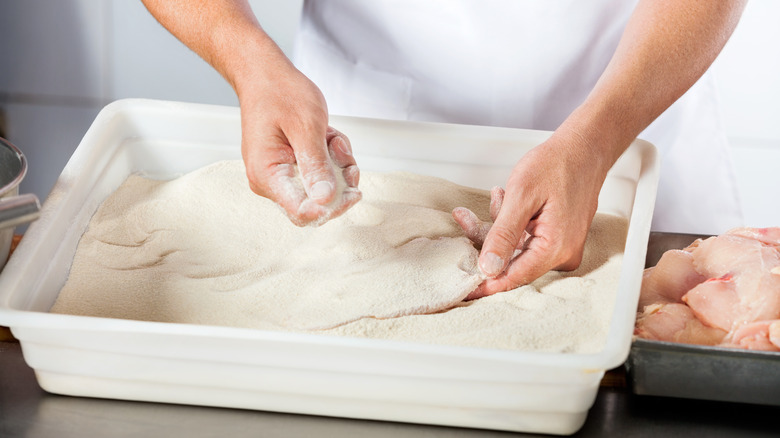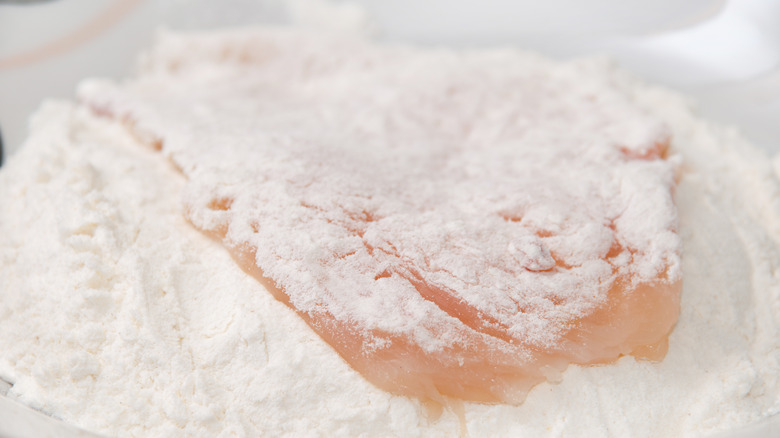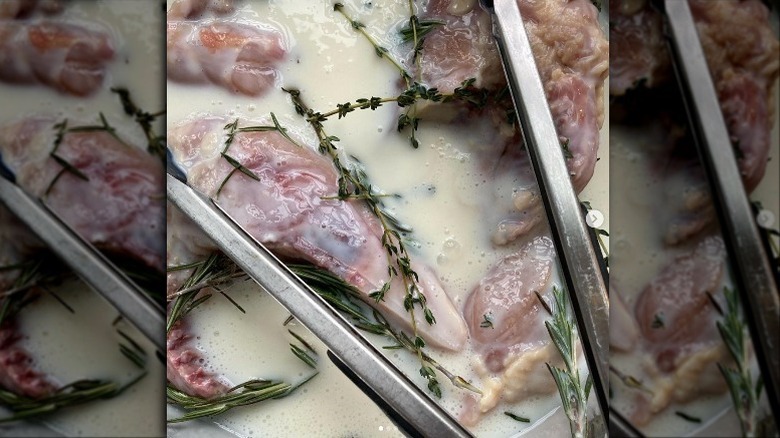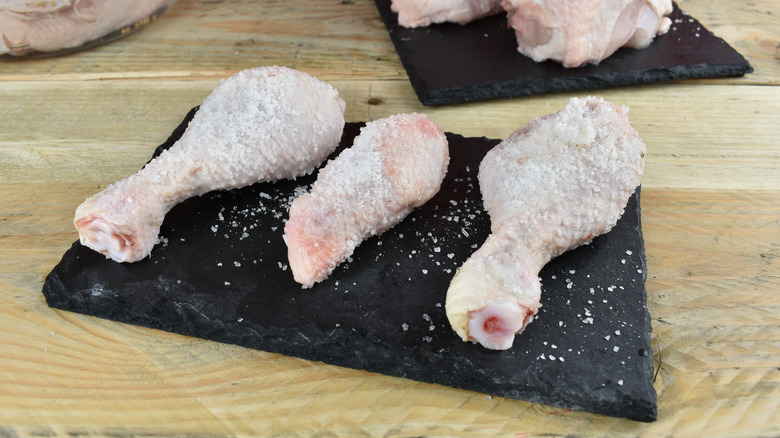12 Fried Chicken Myths You Probably Believe
There's something about fried chicken that always has us coming back for more. It's juicy, it's crunchy, and it seems to make every event just a little bit better. While it may be known as a Southern food in the United States, different versions of fried chicken are popular around the world. However, as with any food as popular and wide-ranging as fried chicken, you'll find plenty of myths that are served up with your wings and drumsticks. Whether you're attempting to prepare a batch at home or just trying to find the best fried chicken joint in your local area, it's a good idea to get the lowdown on these fallacies so you can avoid them.
Don't worry: We've done the hard work for you so you can spend less time researching and more time eating. Take a look at some of these fried chicken myths you may already believe, and read on to learn why these myths have been busted. The more you know, the more likely you are to make (or buy) that truly delicious fried chicken you want and deserve. Let's get cooking!
You should crisp your fried chicken in the oven
There are several different important factors that go into making amazing fried chicken, but we can all agree on one thing: Fried chicken should be super crispy on the outside. That's all part of the pleasure, right? Not only does something that crispy taste great, but even the sound of biting into a drumstick can probably make your mouth water. And because of that, some fried chicken cooks will go to great lengths to get the perfect amount of crispiness. However, if you think the best way to get that crispy crunch you want is to put your fried chicken in the oven, we have to tell you that you're wasting your time.
That's because the real magic of fried chicken happens in the breading. If you get the breading right and you fry your chicken at the correct temperature, then it's going to get plenty crispy on its own. Therefore, using your oven is unnecessary — it just adds another step that you probably don't want to deal with, especially when you're making your fried chicken for a cookout in the middle of the summer. Save yourself some time and forget about throwing your chicken in the oven.
It's okay to skip the breading for low-carb fried chicken
These days, many people are trying to be healthier on a daily basis, and we can only commend those efforts. After all, you want to feel your best, so why wouldn't you try to eat healthy? However, that often leads home cooks to attempt recipes that alter their favorite foods to make them more diet-friendly. If you're on the keto diet or you're just trying to put fewer carbs on your plate, you may be tempted to try making some low-carb fried chicken by omitting the breading completely. This might seem like a smart trick, but you're bound to be disappointed by the results.
Why? According to Chef Works, the breading is absolutely essential. First of all, it provides that crunch that we discussed above, and you certainly don't want to miss out on that. But it also plays another important role: sealing in the moisture. Without that seal, your fried chicken is likely to get kind of dry and sad-looking, it's certainly not going to be appealing when you bite into it, and it's just dry and greasy as opposed to crispy and moist.
Of course, there are plenty of other tasty ways to prepare chicken if you don't want the extra calories from the breading. But if naked chicken is your MO, then frying it just isn't for you.
Fried chicken is an everyday thing
If you're not from the South, then you probably have some ideas in the back of your head what the region is all about. No, not everyone has a banjo, and yes, summers are miserable without air conditioning. But there's even more confusion about Southern food specifically. One common assumption is that fried chicken is a food that people eat all the time. While it may be more common and ubiquitous now that chains like KFC and Popeyes abound, that's not how the tradition of fried chicken started. Rather than being an everyday thing, it was regarded more as a food for celebration, as per First We Feast. They note, "Fried chicken, fried fish, cakes, cobblers and pies — all that stuff was meant for celebratory occasions, not everyday eating."
We know, it's a bummer. You wanted an excuse to eat fried chicken on the daily. But considering that it takes quite a bit of work to make, it's reasonable that it's mainly reserved for special events. But that's just a reason to host a fun, casual dinner party, right?
You should only fry the drumsticks
When you think of fried chicken, what kind of piece comes to mind? If you're like most people, you'll think of a drumstick. This piece is pretty iconic in the world of fried chicken, and we can't deny that it's one of the best. The juicy dark meat is ideal for frying because it already contains a lot of fat. However, it's a myth that the drumstick is the only part of the chicken worth frying. In fact, according to Bon Appétit, you can actually feel free to fry the entire bird.
That may come as a surprise if you haven't done it before, but it's true. And one part you probably wouldn't think about frying is the breast. Since the breast contains more lean white meat than other cuts, it's more difficult to cook without drying out, but that's what makes it such a good candidate for frying — it'll help it retain some of its juiciness.
However, it's probably a good idea to cut your breast into smaller pieces so you're not attempting to cook a massive piece of chicken all the way through.
It's not necessary to dry your chicken before frying it
Since fried chicken is such an iconic food, it may seem like making it is a pretty straightforward process. Perhaps that's why so many people are somewhat careless when preparing all the different components of the frying process. One common chicken-frying myth is the idea that you don't have to do anything to the chicken before dredging your pieces and throwing them in the pan. In fact, you do.
It's super important to make sure that you dry your chicken well before you start dredging it. That's because the flour and spices won't adequately stick to the skin if it's still very wet. Instead of a nice, even coating, you'll be more prone to flour lumps that will make biting into your fried chicken a less-than-appealing experience.
It may seem like a hassle, but patting your bird dry very well with a paper towel before you start preparing it for the frying process is an essential step when it comes to making fried chicken. You definitely shouldn't take this myth to heart.
You need a deep fryer to make fried chicken
If you've ever cooked anything in a deep fryer before, you know it's a lot of work. It requires a lot of oil, which can be expensive. And it's also a massive mess to clean up once you're done. And unfortunately, this keeps a lot of people from making their own fried chicken at home because they believe the myth that you have to make it in a deep fryer. However, that couldn't be further from the truth — you don't have to go out and buy any new equipment to make fried chicken as long as you already have the basics in your kitchen.
In fact, Chef Works asserts that not only can you use a cast iron skillet for frying your chicken, it may actually even be a better choice. That's because it's easier to get cast iron to the temperature you want it at, and it retains heat more effectively. Also, it's a lot easier to work with when you need to move your pieces of chicken around in the pan.
And since a cast iron skillet can be used for so many other purposes in the kitchen, it's definitely worth the money to invest in one if you plan on making fried chicken on a regular basis.
It's okay to fry chicken that just came out of the fridge
Imagine this: You've been planning on making fried chicken for dinner all day. You finally get home from work and decide you don't want to wait another second to sink your teeth into that juicy, delicious flesh — you have to make the chicken now. So, you take it out of the fridge, dredge it, fry it up, and start eating. But wait ... something's off. What is it? Well, it's probably because you believed the myth that you can take your chicken straight out of the fridge and start frying it immediately. However, this is a big no-no, according to Bon Appétit.
Frying chicken when it's cold is a bad idea because it will lower the temperature of the oil once you drop it into the pan, causing the chicken to cook unevenly. When this happens, you can be left with undercooked chicken (definitely something you want to avoid) or overcooked chicken that just doesn't taste as good as it should. Additionally, this kind of ruins your chances at getting a crispy skin.
So, what's the solution? That's easy. Just make sure you set your chicken out on the counter for about 30 minutes before you start frying. You'll have to wait a little longer, yes, but it'll all be worth it in the end.
You can tell when your fried chicken is done just by looking at it
Here at Mashed, we believe in your cooking abilities. But even if you're an incredibly accomplished home cook, you shouldn't believe the myth that you know if a piece of chicken is fully cooked just by looking at it — and that's especially true if you're frying it. While you may be able to get a sense of how close it is to being done just by looking at the outside of the piece of chicken, you'll never really know if it's safe to eat unless you use a meat thermometer to take the chicken's temperature, according to Chef Works.
Take the meat thermometer and put it into the thickest part of the chicken (but you'll want to avoid the bone). The temperature should read 165 degrees Fahrenheit to ensure a safely cooked chicken. Not only is this important to avoid food-borne illness from undercooked poultry, it will also prevent you from overcooking your chicken into a dry mess.
You don't need to season your flour before you dredge
Look, we get it: You lead a busy life. You have a lot going on, so you don't want to add any extra, unnecessary steps to the cooking process. That's especially true when it comes to a time-intensive project like frying chicken. However, you don't want to take any shortcuts when it comes to seasoning your dredging flour. While it's tempting to believe the myth that plain flour will do, it's likely going to leave you with a lot less flavor than you really want in your chicken, according to Southern Living. And the last thing that anyone wants is a bland crust.
Southern Living suggests keeping it classic and simple with just some salt and pepper added to your dredging flour, but you can really get as creative as you want here. Some chili powder would be a nice addition if you like your chicken with some kick, or you can experiment with ingredients like garlic and onion powder, paprika, or even white pepper. Stick to a flavor combo you love, and we can guarantee that your fried chicken will come out so much better than it would be if you were to skip the seasoning step entirely.
You should dredge your chicken twice before frying
Have you heard the myth that you're always supposed to dredge your chicken twice before you start frying it? It's a common sentiment, and it seems to make sense. After all, wouldn't the crust be crispier if you added even more flour to it? You would think so, but that's not necessarily the case, per Southern Living. Instead, they say that this will result in a soggy crust, which is probably the last thing you want when it comes to your fried chicken.
Instead, you can use this method they provided for incredibly easy dredging. Instead of dipping your chicken into bowls of flour, add the seasoned flour to a zip-top bag. Put some chicken into the bag as well (making sure not to overfill it), and turn the bag until it is well-coated. Repeat with any remaining batches, and you've just dredged your chicken in the simplest way possible. Wasn't that easy? Give it a try if you're making a lot of fried chicken at once — you might just save yourself a lot of time. And forget about the double dredge altogether!
There's no need to brine fried chicken
When you roast or bake a chicken, you probably already know that you should brine the bird. Not only does it help keep the flesh moist, but it also imparts a lot of flavor, and that's super important when you're working with a relatively neutral-tasting protein like chicken. However, many people assume that this step isn't necessary when it comes to fried chicken. After all, it's getting fried, so you wouldn't think that it needs extra moisture. And aren't you getting all that flavor from the breading anyway?
While it may not be an absolute necessity to brine your fried chicken beforehand, it's going to make it taste a lot better. That's exactly why Bon Appétit recommends brining your chicken for at least four hours before you start the cooking process. They use buttermilk, which is definitely one of the most popular ways to create a brine. Want to make your chicken even more flavorful? They say you can leave your chicken in the brine for up to 24 hours, so don't be afraid to let it sit overnight.
Buttermilk brine is the only way to go
While you already know that buttermilk brine is an option with your fried chicken, there are other ways to impart added moisture and flavor into your bird. Some people just don't like to use buttermilk, and others have specific reasons not to opt for this combo (if you're Jewish and keep kosher, for example). Therefore, you shouldn't believe the myth that a buttermilk brine is the only way to go when there are so many other brining methods out there.
The Taste of Kosher has a few ideas that are going to land you with a super-flavorful chicken that'll be ready to fry in no time. If you want to keep things nice and easy, you can ditch the buttermilk in favor of coconut milk. Coconut milk has a slight acidity to it, so it works surprisingly well. But you can also try a dry brine. Basically, that just involves rubbing salt onto the skin of the chicken. Don't be afraid to combine that salt with other seasonings to add even more flavor.
And if you're looking for something a little out of the ordinary, pick up a papaya the next time you're at the store. The enzymes in this fruit will help break the flesh of the chicken down, resulting in a tenderness that you'll want to replicate again and again.
